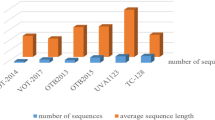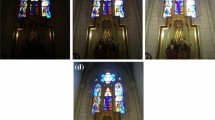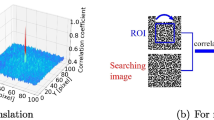Abstract
An edge detection method based on a fuzzy cellular automata model which serves as the relaxation labeling process constraint is described. An initial estimate of edge locations is made and the remaining ambiguities are resolved by thinning and enhancing the edges through several iterations. An efficient fixed step algorithm is presented and its performance is evaluated for different noise level images. The method is useful for the detection of linear image features in three-dimensional robot vision systems.
Similar content being viewed by others
References
Ballard, D.H. and Brown, C.M.,Computer Vision, Prentice-Hall, 1982.
Burks, A.W. (ed),Essays on Cellular Automata, Univ. Illinois Press,1970.
Burns. B.J., Hanson. A.R. and Riseman. E.M., Extracting straight linesIEEE Trans. Pattern Anal. Mach. Intell. PAMI-8 (4), 425–455 (1986).
Canny. J., A computational approach to edge detection,IEEE Trans. Pattern Anal. Mach. Intell. PAMI-8 (6), 679–698 (1986).
Duff, M.J.B. and Watson, D.M., CLIP3: A cellular logic image processor, in.New Concepts and Technologies in Parallel Information Processing (ed. E.R. Caianiello), Noordhoff, 1975.
Fekete. G., Eklundh. J. and Rosenfeld. A., Relaxation: Evaluation and applications,IEEE Trans. Pattern Anal. Mach. Intell. PAMI-3 (4), 459–469 (1981).
Fountain, T.J., CLIP4: A progress report, inLanguages and Architectures for Image Processing, (eds. M.J.B. Duff and S. Levialdi), Academic Press, 1981.
Glazer, C., Multilevel relaxation in low-level computer vision, inMultiresolution Image Processing and Analysis, (ed. A. Rosenfeld), Springer, 1984.
Haralick. R.M., Digital step edges from zero crossing of second directional derivatives,IEEE Trans. Pattern Anal. Mach. Intell. PAMI-6(1), 58–78 (1984).
Horn, B.K.P.,Robot vision, MIT Press, 1986.
Hummel. R.A. and Zucker. S. W., On the foundations of relaxation labeling processes,IEEE Trans. Pattern Anal. Mach. Intell. PAMI-5(3), 267–287 (1983).
Koch. M.W. and Kashyap. R.L., Using polygons to recognize and locate partially occluded objects,IEEE Trans. Pattern. Anal. Mach. Intell. PAMI-9(4) 483–494 (1983).
Kundu. A. and Mitra. S.K., A new algorithm for image edge extraction using a statistical classifier approach,IEEE Trans. Pattern Anal. Mach. Intell. PAMI-9(4), 569–577 (1987).
Levine, M.D.,Vision in Man and Machine, McGraw-Hill, 1985.
Lowe, D.G.,Perceptual Organization and Visual Recognition, Kluwer, 1985.
Lowe, D.G., Three-dimesional object recognition from single two-dimensional images, TR 202 (RR 62), Courant Institute of Mathematical Sciences, NYU, 1986.
Lunscher. W.H.H.J. and Beddoes. M.P., Optimal edge detector design I: Parameter selection and noise effects,IEEE Trans. Pattern Anal. Mach. Intell. PAMI-8(2), 164–177 (1986).
Lunscher. W.H.H.J. and Beddoes. M.P. Optimal edge detector design II: Coefficient Quantization,IEEE Trans. Pattern Anal. Mach. Intell. PAMI-8(2), 164–177 (1986).
Marr. D. and Hildreth. E., Theory of edge detection,Proc. Royal Society (London) ser.B 207, 187–217 (1980).
Marr, D.,Vision, Freeman, 1982.
Medioni. G.G. and Nevatia. R., Matching images using linear features,IEEE Trans. Pattern Anal. Mach. Intell. PAMI-6(6), 675–685 (1984).
Mohammed. J.L., Hummel. R.A. and Zucker. S.W., A gradient projection algorithm for relaxation methods,IEEE Trans. Pattern Anal. Mach. Intell. PAMI-5(3), 330–337 (1983).
Nalwa. V.S. and Binford. T.O., On detecting edges,IEEE Trans. Pattern Anal. Mach. Intell. PAMI-8 (6), 699–714 (1986).
Nevatia, R.,Machine Perception, Prentice-Hall, 1982.
Pavlidis, T.,Algorithms for Graphics and Image Processing, Computer Science Press, 1982.
Prager. J., Extracting and labeling boundary segments in natural scenes,IEEE Trans. Pattern Anal. Mach. Intell. PAMI-2(1), 16–27 (1980).
Preston. K., Duff. M.J.B., Levialdi. S., Norgrem. P.E. and Toriwaki. J.I., Basics of cellular logic with some applications in medical image processing,Proc. IEEE 67(5), 826–856 (1979).
Preston. K., Gray level processing by cellular logic transforms,IEEE Trans. Pattern Anal Mach. Intell. PAMI-5(1), 55–58 (1983).
Preston, K. and Duff, M.J.B.,Modern Cellular Automata: Theory and Applications, Plenmum Press, 1984.
Rosenfeld, A., Relaxation methods in image processing and analysis,Proc. 4th Int. Joint Conf. Pattern Recognition, 1978, pp. 181–185.
Shapira. R., The use of objects' faces in interpreting line drawings,IEEE Trans. Pattern Anal. Mach. Intell. PAMI-6(6), 789–794 (1984).
Shapira. R., More about polyhedra—Interpretation through constructions in the image plane,IEEE Trans. Pattern Anal. Mach. Intell. PAMI-7(1), 1–16 (1985).
Sugihara. K., A necessary and sufficient condition for a picture to represent a polyhedral sceneIEEE Trans. Pattern Anal. Mach. Intell. PAMI-6(5), 578–586 (1984).
Toffoli, T. and Margolus, N.,Cellular Automata Machines: A New Environment for Modeling MIT Press, 1987.
Torre. V. and Poggio. T.A., On edge detection,IEEE. Trans. Pattern Anal. Mach. Intell. PAMI-8(2), 147–163 (1986).
Von Neumann, J., The general logical theory of automata, inCerebral Mechanisms in Behavior—The Hixon Symposium (ed. L.A. Jeffries), Wiley, 1951.
Von Neumann, J.,Theory of Self-Reproducing Automata (ed. A. Burks, Univ. Illinois Press, 1966).
Waltz, D., Understanding line drawings of scenes, with shadows, inThe Psychology of Computer Vision (ed. P.H. Winston), McGraw-Hill, 1975.
Wolfram S. (ed.),Theory and Applications of Cellular Automata, World Scientific, 1986.
Zucker. S.W., Hummel. R.A. and Rosenfeld. A., An application of relaxation labeling to line and curve enhancement,IEEE Trans. Computers C-26(3), 394–403 (1977).
Zucker, S.W. and Parent, P., Multiple-size operators and optimal curve finding, inMultiresolution Image Processing and Analysis (ed. A. Rosenfeld), Springer, 1984.
Author information
Authors and Affiliations
Rights and permissions
About this article
Cite this article
Surka, S., Valavanis, K.P. A cellular automata model for edge relaxation. J Intell Robot Syst 4, 379–391 (1991). https://doi.org/10.1007/BF00314941
Received:
Accepted:
Issue Date:
DOI: https://doi.org/10.1007/BF00314941




